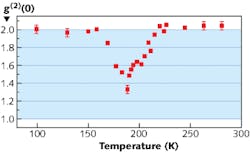
Researchers at the Technischen Universität Darmstadt (Darmstadt, Germany) have demonstrated a state of light that is at the same time incoherent in the first order (spectrally broadband) and yet coherent in the second order. Based on an electrically pumped superluminescent diode (SLD), the intensity-stabilized source could be ideal for optical coherence tomography (OCT).
Normally, lasers show a zero-lag (at a Michelson delay time equal to zero) intensity correlation of 1 accompanied by Poissonian statistics, whereas thermal or incoherent radiation exhibits an enhanced correlation of g(2)(τ=0) =2, thus showing photon bunching. The TU Darmstadt quantum-dot (QD) SLD emits at a wavelength around 1200 nm with a broad spectral bandwidth of several tens of terahertz, originating from amplified spontaneous emission (ASE).
The emission spectrum is determined by the QD specifics, as emission from a ground state and an excited state arising from the quantized and strongly inhomogeneously broadened QD energy scheme. A modern version of the Hanbury-Brown-Twiss second-order correlation experiment exploited the effect of two-photon absorption in a photomultiplier tube, thus enabling highly resolved temporal second-order coherence investigations of spectrally broadband sources. At room temperature, the SLD’s incoherent emission shows up as a second-order correlation of two.
However, when lowering the temperature, the Darmstadt group found at a specific temperature a reduction of the second-order correlation at zero delay to a value of 1.3. The low temperature reduces the interaction of the charge carriers in the individual QDs (due to a shrinkage of the Fermi distribution in energy space), causing the charge carriers to condense into the lowest-lying QD ensemble states.
The accompanying higher optical gain produces a still-dominant ASE process but with some components of a more stimulated process such that the photon statistics resemble those of a laser, therefore becoming less bunched—and yet keeping a spectrally broadband character. Contact Martin Blazek at [email protected].

John Wallace | Senior Technical Editor (1998-2022)
John Wallace was with Laser Focus World for nearly 25 years, retiring in late June 2022. He obtained a bachelor's degree in mechanical engineering and physics at Rutgers University and a master's in optical engineering at the University of Rochester. Before becoming an editor, John worked as an engineer at RCA, Exxon, Eastman Kodak, and GCA Corporation.